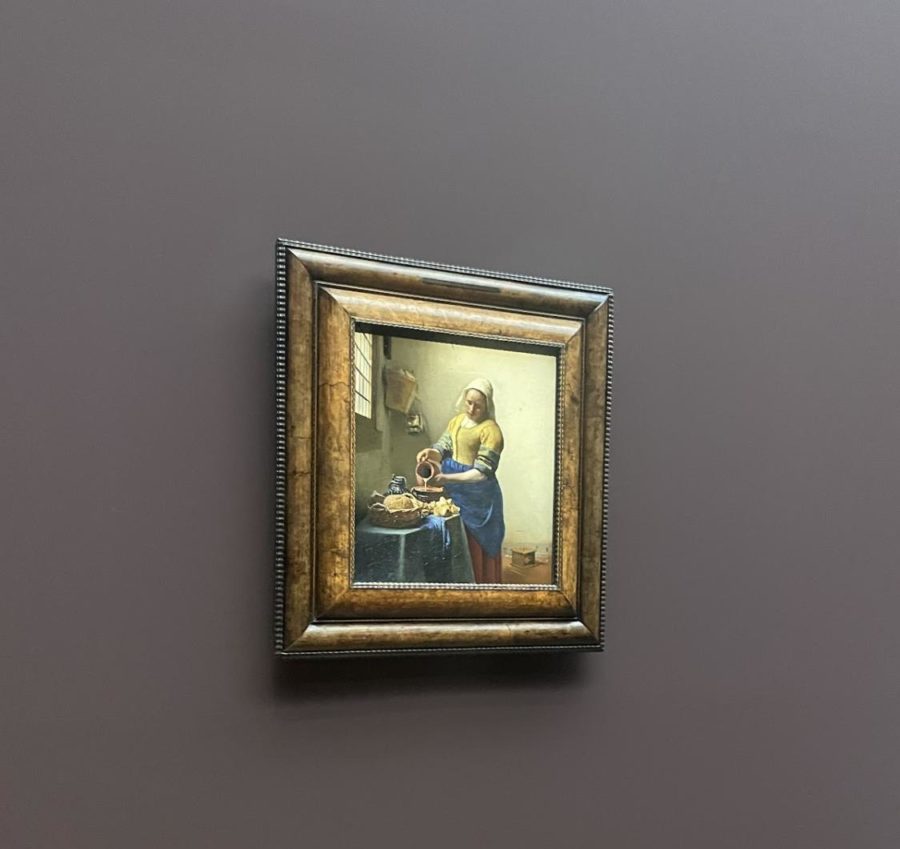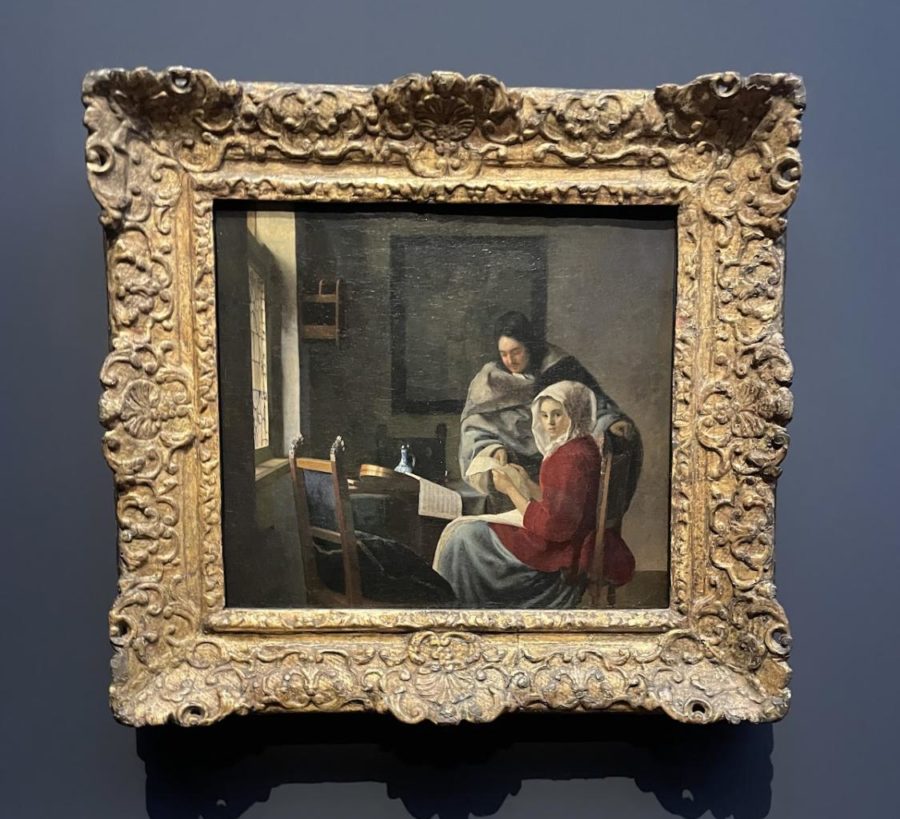‘Vermeer’ and the Beauty in the Ordinary
Much of the work of the Dutch Golden Age artist Johannes Vermeer is gathered together in a monumental and historic exhibition at the Dutch Rijksmuseum, begging the question – why is this small town painter so beloved?
Vermeer’s ‘The Milkmaid’, painted in 1658, is a crown jewel of the retrospective and one of the first times in his career that Vermeer painted a woman, who is alone, performing a domestic task. This theme became prevalent in his later paintings.
Johannes Vermeer ranks amongst the most esteemed artists of all time. He has an almost fanatical following, and tickets for the largest ever exhibition of his work sold out in mere weeks. But when he died penniless in 1675, Vermeer was a struggling painter whose work was known by very few. So how exactly did the “Sphinx of Delft” go from a small town provincial artist to Dutch Golden Age savant?
Born in Delft, Holland to a middle class family, Vermeer was introduced to art through his father, Reynier Janszoon Vermeer, who became a prominent art dealer after years of making a living as a weaver. It was his work that initially exposed Vermeer to the conventions of old masters.
There is scarcely anything known about the early phases of Vermeer’s career. He married into a Catholic family, which inspired his early religious works. He registered as a master painter at the Delft’s Guide of Saint Luke , but nothing is known about his apprenticeship, training, or his master’s identity. It is theorized that Vermeer perhaps traveled abroad in the late 1640’s and was influenced by works of Carravaggio and Rembrant. Vast Biblical works completed early in his career, including Diana and Her Companions and Christ in the House of Mary and Martha, are particularly evocative of Rembrant’s work.
Over time, the more prominent religious panels gave way to smaller, more intimate scenes of everyday life and 17th century domesticity. Vermeer’s work intensely centered around the behavior of light and other optical effects, which became trademarks of his paintings. The way in which he used chiaroscuro, or the effects of light and shadow, was revolutionary. This, combined with his manipulation of space and dimension, amounted to a small artistic following in Delft.
Sadly, the disastrous Dutch economy took its toll on the Vermeer family. Leaving behind a mere 45 paintings and enormous debt, Vermeer died in 1675 at only 43 years old.
His success during his lifetime was moderate at best, and outside of Delft, Vermeer was a mostly unknown artist. For centuries after his death, his pieces were barely acknowledged and often attributed to more prolific Dutch painters.
It would have stayed that way if not for one French art critic, William Burger. His rave reviews on Vermeer’s largely unknown work in the 1880s paved the way for a widespread Vermeer-boom in the late 19th and early 20th century. Prices for his pieces quickly skyrocketed as private collectors and museums struggled to get their hands on the minimal number of works.
This popularity only continued to grow over the 20th century. This was in part due to Vermeer’s unique style and remarkable use of light, but also to the drama surrounding his artworks. Due to the few pieces he produced, Vermeer artworks became highly coveted for their scarcity. Today, only about 35 Vermeer paintings remain in the world.
To top it all, the fanatical cult of Vermeer has been further whipped into a frenzy over the art world’s newest development: a blockbuster collection of 28 Vermeer paintings, the largest in history, gathered at the Rijksmuseum in Amsterdam for an exclusive exhibit, which opened on February 10th, 2023 and runs through June 4th, 2023 (it is entirely sold out, however, as of this article’s publication, but you can explore the entire exhibition online using THIS LINK and by clicking on ‘Closer to Johannes Vermeer,’ which is charmingly narrated by English actor Stephen Fry.
I had the privilege of visiting this Vermeer exhibit this past April 2023. The city of Amsterdam was in full hustle as my family and I made our way up the canals and to the museum, occasionally ducking to the side as a bicycle whizzed past us on the street. Built in 1789, the Rijksmuseum’s building is quite imposing – a mix of reddish neo-Gothic towers and sloping arches that are striking amongst the more modern buildings of Amsterdam’s museum quarter. After a short line, we entered the marble clad interior.
The idea for the exhibition, simply entitled ‘Vermeer,’ was sparked after curators realized previously unloanable – and highly treasured – paintings at the Frick museum in New York City would be able to make the flight across the Atlantic. Plans for the retrospective began soon after and developed into a 28 piece exhibition, with roughly 7 more paintings than were at the former largest exhibit of Vermeer at The National Gallery of Art in Washington DC a few decades ago.
Not only is the amount of Vermeer paintings presented unprecedented, but also the willingness of so many institutions to donate their precious pieces. Seven years of careful diplomacy and meetings went into gathering the collection, which was further complicated by the Russian invasion of Ukraine and the Coronavirus pandemic. As Jason Farago puts it in the New York Times, “To call it rare is to undersell it severely.”
The simplicity of the exhibit – the lack of furniture and ornate detail – is part of what makes it so special. There are no distractions to steal your eyes away from the true jewels of the room, the paintings. They shine ever more brightly against the blank walls.
The exhibit is spread out and paced; the viewer begins with Vermeer’s cityscapes, most notably the View of Delft, and then enters the room of his early, religious paintings, including Diana and her Companions and the Procuress, made shortly after his transition to Catholicism.
The next room, holding the famed Milkmaid, is empty. Three blank walls circle the tiny painting, their deep purple contrasting against the mahogany frame. This room has a quiet solitude, evocative of Vermeer’s work. Every one of his paintings seems to emit a sort of quiet, a peace in the everyday tasks and bits of life.
I stood in front of the Milkmaid for almost 10 minutes, snapping a total of one picture, taken right as I had walked into the room. I mostly just stared at the remarkable piece, noticing Vermeer’s intense eye for detail that resulted in a depiction of the soft light coming from the left, the dribble of the milk, and the rich blue of the tablecloth.
The Milkmaid, along with the prized Girl With A Pearl Earring, is one of Vermeer’s most popular works. It is the first painting in which he depicts a woman, who is alone, performing a domestic task in an interior, something that is prevalent in his later paintings, and the painting served as a major turning point in his creative evolution.
Also deserving of its own room, and my personal favorite of all of Vermeer’s works, is Girl Reading A Letter At An Open Window. Initially from Dresden, this painting was the most critical work that was restored for the current exhibition. It is also one of Vermeer’s earliest genre scenes. In this painting, we observe a girl in profile reading a letter against an open window, the light just hitting her face as she remains engrossed in the words. Only in 2021 did restorers finish removing the overpaint to reveal the cupid figure in the back of the painting. The letter is now a love letter, and the cupid looming over serves as a reminder of the blessing, or the price, of love.
The room that follows is the ‘tronie room,’ complete with the Lacemaker, Girl with the Red Hat, the controversial Girl With A Flute, and a few others. Many believe that Girl With a Flute is not a genuine Vermeer, but merely an inspiration made by one of his associates. Regardless of the discussion, it is attributed to Vermeer in the exhibition, with only a tiny mark beside the work indicating that its true painter is still to be determined by outside scholars. During Vermeer’s time, portraits that depicted exaggerated or typical facial expressions were known as ‘tronies,’ and Vermeer painted several of them.
Two additional, quite larger rooms in the exhibit hold the paintings of Vermeer’s prime working years. The first room displays the only paintings featuring men and women together in the exhibit, Girl Interrupted at her Music, The Glass of Wine, and Officer with a Laughing Girl. Yet, key aspects of the paintings remain similar: the characteristic paned window on the left, the various art on the wall behind, and the tables. Even amongst the variety of Vermeer’s work, there are constant thematic elements in each painting, trademarks of Vermeer’s style and of his mind.
The exhibition closes with more classic works by Vermeer: The Geographer (twin to The Astronomer which is not featured in the exhibit), Mistress and Maid, Woman Holding a Balance, and Woman With a Pearl Necklace. There is the calm in these paintings, and one absorbs the classic Vermeer stillness through gazing at them. But there is more. We leave the exhibit invigorated by and transfixed in the ordinary world depicted in these paintings: the woman writing a letter to a loved one, the weighing of jewelry, a woman conversing with a maid. In our current world that is often frantically moving and chaotic, Vermeer and his paintings push us to stop and observe the ordinary, and ask us to savor the small and beautiful details in the world around us.
That, in itself, is Vermeer’s true gift.
There are no distractions to steal your eyes away from the true jewels of the room, the paintings. They shine ever more brightly against the blank walls.
Allegra Lief is a Copy Chief for The Science Survey and is responsible for the review and revision of her peers' articles prior to publication. Through...












